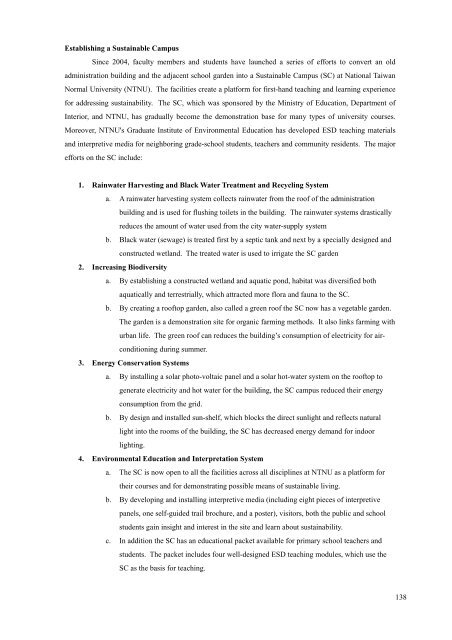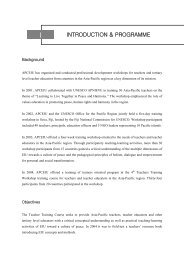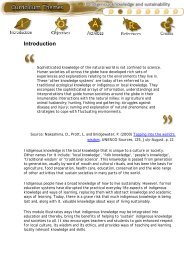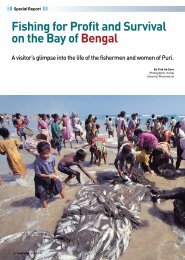REPORT OF UNESCO EXPERT MEETING ON - APCEIU
REPORT OF UNESCO EXPERT MEETING ON - APCEIU
REPORT OF UNESCO EXPERT MEETING ON - APCEIU
Create successful ePaper yourself
Turn your PDF publications into a flip-book with our unique Google optimized e-Paper software.
Establishing a Sustainable Campus<br />
Since 2004, faculty members and students have launched a series of efforts to convert an old<br />
administration building and the adjacent school garden into a Sustainable Campus (SC) at National Taiwan<br />
Normal University (NTNU). The facilities create a platform for first-hand teaching and learning experience<br />
for addressing sustainability. The SC, which was sponsored by the Ministry of Education, Department of<br />
Interior, and NTNU, has gradually become the demonstration base for many types of university courses.<br />
Moreover, NTNU's Graduate Institute of Environmental Education has developed ESD teaching materials<br />
and interpretive media for neighboring grade-school students, teachers and community residents. The major<br />
efforts on the SC include:<br />
1. Rainwater Harvesting and Black Water Treatment and Recycling System<br />
a. A rainwater harvesting system collects rainwater from the roof of the administration<br />
building and is used for flushing toilets in the building. The rainwater systems drastically<br />
reduces the amount of water used from the city water-supply system<br />
b. Black water (sewage) is treated first by a septic tank and next by a specially designed and<br />
constructed wetland. The treated water is used to irrigate the SC garden<br />
2. Increasing Biodiversity<br />
a. By establishing a constructed wetland and aquatic pond, habitat was diversified both<br />
aquatically and terrestrially, which attracted more flora and fauna to the SC.<br />
b. By creating a rooftop garden, also called a green roof the SC now has a vegetable garden.<br />
The garden is a demonstration site for organic farming methods. It also links farming with<br />
urban life. The green roof can reduces the building’s consumption of electricity for airconditioning<br />
during summer.<br />
3. Energy Conservation Systems<br />
a. By installing a solar photo-voltaic panel and a solar hot-water system on the rooftop to<br />
generate electricity and hot water for the building, the SC campus reduced their energy<br />
consumption from the grid.<br />
b. By design and installed sun-shelf, which blocks the direct sunlight and reflects natural<br />
light into the rooms of the building, the SC has decreased energy demand for indoor<br />
lighting.<br />
4. Environmental Education and Interpretation System<br />
a. The SC is now open to all the facilities across all disciplines at NTNU as a platform for<br />
their courses and for demonstrating possible means of sustainable living.<br />
b. By developing and installing interpretive media (including eight pieces of interpretive<br />
panels, one self-guided trail brochure, and a poster), visitors, both the public and school<br />
students gain insight and interest in the site and learn about sustainability.<br />
c. In addition the SC has an educational packet available for primary school teachers and<br />
students. The packet includes four well-designed ESD teaching modules, which use the<br />
SC as the basis for teaching.<br />
138








